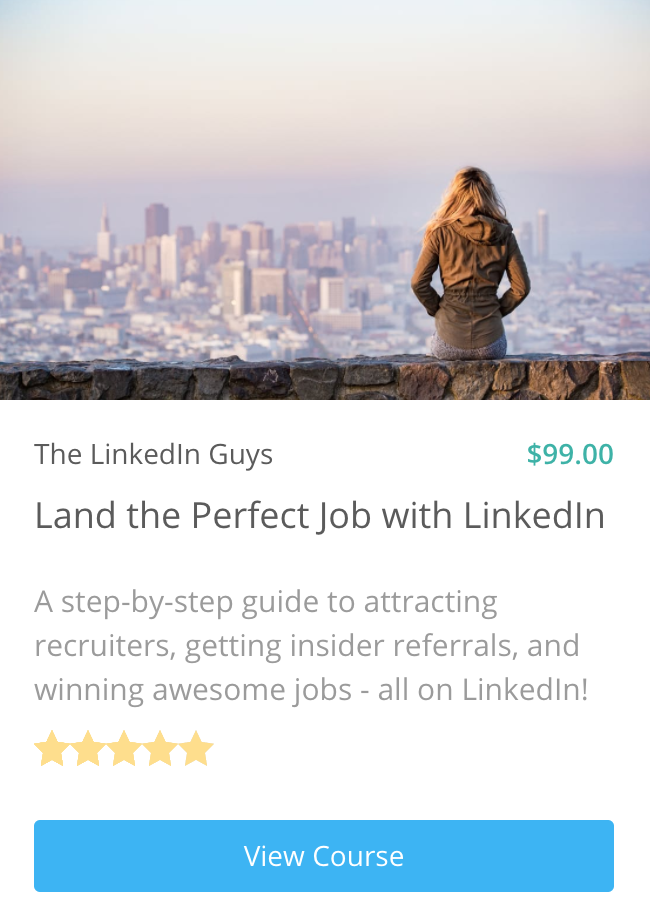The Truth about Career Change
Let’s be honest: Career change is hard.
While you may desperately want to become a web developer, data scientist, or digital marketer, the recruiters for those roles want you to stay put.
Why?
Because sad to say, your attempt to apply for those jobs makes their lives harder. After all, if you were a recruiter who’s been told to find five great web developers, would you want to waste your time on a candidate who’s never been a web developer before?
Heck, no.
You’d do what recruiters throughout the world have always done: Pick the obvious candidates. The ones who’ve done this job a million times before. The ones who can code in their sleep.
Because no recruiter has ever been fired for bringing in an obvious candidate.
So that’s what you’re up against as a career-changer - a professional blockade designed to keep you out. And that’s why career change is hard - really, really hard.
What career change can feel like
The Solution to the Recruiter Blockade
OK, so what’s a would-be career-changer to do?
Well, with any blockade, there’s always the attempt to go right through it. “Maybe if I work really hard on my resume…,” you think. “Or maybe I can become best buddies with the recruiter?”
Nope. Don’t think the recruiters haven’t thought of those things. That’s why they’ve trained themselves to screen out non-experienced resumes in five seconds flat. That’s why your email to the recruiter always ends up like a sad, unrequited love letter.
Which means that, if you can’t go right through the recruiter blockade, you’re going to have to go around it. Luckily, you happen to be reading the ultimate guide to doing just that…
How to handle recruiters
Introducing: The Recruiter End-Around (AKA “The Referral”)
Now, even though recruiters typically exercise ironclad control over who gets interviewed, there’s one important exception: The Referral.
That’s because if someone on the inside can vouch for you, it’s a lot harder for the recruiter to say “No.” While they may have no qualms about dissing you personally, no recruiter wants to explain to their colleague why they dissed that colleague’s preferred candidate.
Which is why referrals are so powerful. Because they take the decision out of the hands of the recruiter and dramatically increase your odds of getting the job. As in 10x more likely, based on the most recent study.
Referral Step 1: Find Your Hidden Network
At this point, you’re probably thinking: “Well, thanks for nothing Jeremy! You got me all excited about getting past recruiters - but how can I get a referral when I don’t even know anyone at my dream company?”
And while this may feel like a Career Catch-22 (“So I need to already know people on the inside just to get on the inside???”), there’s an easy 3-step process to break through at any company, no matter your background.
The first step is to shed light on your hidden network. This means expanding your ally base from the 25 people you spend the most time with today (family, friends, coworkers) to the 2,500 people you’ve known in your life.
Not only is this lifetime base much broader, but these less familiar contacts are actually better placed to help you as a career-changer. That’s because research on these “weak ties” shows that instead of knowing all the same people and companies you do (i.e., no help!), they actually have connections into different companies and jobs - and maybe even the exact ones you want to break into.
And while you could try to build a list of these thousands of weak ties by hand, LinkedIn has an easy shortcut built-in:
Go to LinkedIn’s My Network page
Connect with everyone you recognize in the Recommendations section:
That’s it - with a few quick clicks, you’ll have built a directory of basically everyone you’ve ever known. And lest you have any qualms about adding these people on LinkedIn, just remember: This isn’t Facebook or Snapchat. There are no party pix or selfie filters here. Just cold, hard career empowerment.
So when your network is powered up and ready to go, it’s time for…
Referral Step 2: Find an Ally on the Inside
With your network now fully visible, how do you pick the right person to refer you?
Simply follow this formula:
Referral Potential = How Much They Want to Help x How Much They Can Help
In other words, your ideal referrer feels connected to you (so they’re willing to recommend you) AND has power over the team you want to work on (so their recommendation will matter).
Of course, it’s unlikely that you’ll have perfect advocates at every company, so here’s the order that you should search in:
Search LinkedIn by 1st degree connections (people you know directly) at your dream company (e.g., Google)
Then look for 2nd degree connections (i.e., friends of your friends)
Next, people who went to your school (e.g., San Jose State)
Then, people who used to work where you used to work (e.g., REI):
And finally, people who volunteer at the same organization you do (e.g., Habitat for Humanity)
For each search, see if there’s anyone who’s closely connected to the hiring team (e.g., if you want a web developer role, look for current web developers - not marketers) or has leverage over them (an exec, founder, VC, etc.). If not, go to the next search until you find the best combination of someone who can help and wants to help.
And then, when you’ve found your perfect ally on the inside, get ready for…
Referral Step 3: Make the Ask
To transition a potential ally into an actual one, you’ve got to do two things:
Make them want to help
Make it easy for them to help
Here’s how:
1) To make them eager to support your application, it’s critical that you play up what you have in common - whether it’s a shared alma mater, former employer, or civic passion. After all, even the most powerful CEO is still just a human at the end of the day - and we humans are tribal to the core. Which means that your shared affiliation is your tribal link *and* your ticket to a referral.
2) But no matter how much your contact wants to help, they’re unlikely to do so if it’s hard. Especially since the more powerful and influential they are, the less time they have to invest in helping you. Which is why you need to remove any friction from their potential support - from providing them with all the information they need to refer you to writing an introductory message for them to forward.
To see how this all comes together, here’s an example message:
Subject: A favor for a fellow Wolverine?
Hi Bernice,
As a fellow Michigan grad, I was so thrilled to come across your profile on LinkedIn recently. That’s because I’ve been working hard for the last several months to break into the music industry as a web developer. And so when I saw that you had done exactly that at Spotify, it gave me the confidence to do the same.
That said, I know this may be a lot to ask, but I’m wondering if you’d be willing to refer me for the Junior Web Developer role? While I’m relatively new to this space, you can see from my portfolio that I’ve built a strong foundation with React. And my resume speaks to the fact that I’ve been a good colleague and performer everywhere I’ve been since Ann Arbor.
So thanks for considering. If you don’t feel comfortable doing so, no worries at all. And if you are able to refer me, know that I’ll be truly appreciative - and will definitely pay it forward to the next generation of Wolverines!
Go Blue,
Sasha
Note how this message makes it easy and attractive for Bernice to help. Who doesn’t want to be admired by a fellow member of their tribe? Who can say a referral is too hard when all the materials (job link, resume, portfolio) are lined up and ready to go?
And while not every potential ally will come through for you, remember from Step 2 that there are usually multiple options at each company. So if the first request doesn’t work out, just move on to the next person on the list.
Make it easy to say “Yes!”
The Good News about Career Change
OK, so we started by calling out the elephant in the job-seeking room: Career change is hard. That’s just a fact of life, based on the incentives recruiters face to screen out newbies.
But what relatively few job-seekers appreciate is that you don’t have to to let recruiters control your career destiny. There’s actually a completely different and more effective path to landing your dream job - the referral end-around. And it’s wide open to you, no matter how few connections you have in your desired industry.
So as you embark on your new career adventure, just remember that, ultimately, you get to chart your course. And while there will always be obstacles standing in your way, the savvy career-changer doesn’t just ram into them again and again, with the same depressing results. Instead she does what anyone can do in the age of LinkedIn: She goes right around them.
Want to master LinkedIn?
Learn all the LinkedIn techniques that expert job-seekers use: From how to make sure your profile shows up at the top of searches to how to get insider company information before your interview.
Get the first LinkedIn course created by actual LinkedIn employees!









